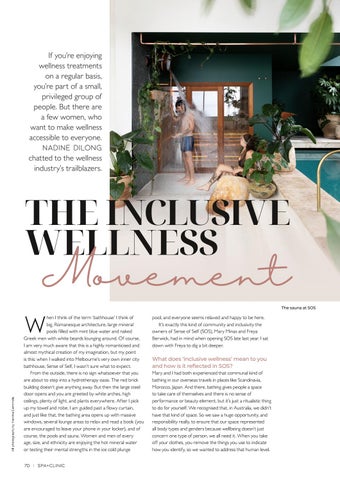If you’re enjoying wellness treatments on a regular basis, you’re part of a small, privileged group of people. But there are a few women, who want to make wellness accessible to everyone. Nadine Dilong chatted to the wellness industry’s trailblazers.
THE INCLUSIVE WELLNESS Movement
All photography by Martina Gemmola
W
hen I think of the term ‘bathhouse’ I think of big, Romanesque architecture, large mineral pools filled with mint blue water and naked Greek men with white beards lounging around. Of course, I am very much aware that this is a highly romanticised and almost mythical creation of my imagination, but my point is this: when I walked into Melbourne’s very own inner city bathhouse, Sense of Self, I wasn’t sure what to expect. From the outside, there is no sign whatsoever that you are about to step into a hydrotherapy oasis. The red brick building doesn’t give anything away. But then the large steel door opens and you are greeted by white arches, high ceilings, plenty of light, and plants everywhere. After I pick up my towel and robe, I am guided past a flowy curtain, and just like that, the bathing area opens up with massive windows, several lounge areas to relax and read a book (you are encouraged to leave your phone in your locker), and of course, the pools and sauna. Women and men of every age, size, and ethnicity are enjoying the hot mineral water or testing their mental strengths in the ice cold plunge 70 | SPA+CLINIC
The sauna at SOS
pool, and everyone seems relaxed and happy to be here. It’s exactly this kind of community and inclusivity the owners of Sense of Self (SOS), Mary Minas and Freya Berwick, had in mind when opening SOS late last year. I sat down with Freya to dig a bit deeper.
What does ‘inclusive wellness’ mean to you and how is it reflected in SOS? Mary and I had both experienced that communal kind of bathing in our overseas travels in places like Scandinavia, Morocco, Japan. And there, bathing gives people a space to take care of themselves and there is no sense of performance or beauty element, but it’s just a ritualistic thing to do for yourself. We recognised that, in Australia, we didn’t have that kind of space. So we saw a huge opportunity, and responsibility really, to ensure that our space represented all body types and genders because wellbeing doesn’t just concern one type of person, we all need it. When you take off your clothes, you remove the things you use to indicate how you identify, so we wanted to address that human level.
